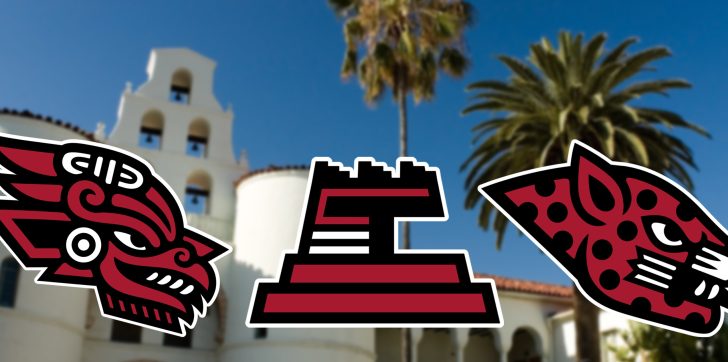SDSU Unveils New Aztec Glyphs to Honor Mind, Body & Soul
San Diego State University just rolled out something big. Not a new stadium, not a celebrity guest speaker, but something deeper: Three powerful Aztec-inspired glyphs that speak to the soul of the campus. It is a visual identity refresh that looks cool and means something deeper.
The new symbols, Ehecatl, Ocelotl, and Calli, stand for mind, body, and soul. They weren’t created overnight.
This is the result of a six-year effort to rethink how SDSU honors Aztec culture.
Ehecatl, Ocelotl, and Calli
Let’s start with Ehecatl. This glyph, tied to wind, reflects thought and intelligence. It honors the feathered serpent god Quetzalcoatl, a symbol of knowledge and curiosity. In Aztec belief, wind touched everything, just like ideas. Ehecatl reminds students that the mind has no borders, and neither does learning.
It tells students to ask big questions, stay curious, and never settle for surface answers.
Next up is Ocelotl. That is the jaguar, the fierce one. This glyph honors the body, like strength, health, and stamina. It connects to Tezcatlipoca, the god of night, time, and deep wisdom. For the Aztecs, the jaguar was a myth. A creature of grit and survival.

SDSU Bookstore / IG / SDSU links this symbol to its core value of education. Ehecatl will show up across campus as a visual cue to keep growing mentally.
In SDSU’s vision, Ocelotl speaks to physical power, wellness, and determination. You will see it on uniforms, in athletic spaces, and anywhere students push their limits.
Now comes Calli, the house. It is the quiet one, but maybe the most important. This symbol represents the soul and what grounds us: home, family, and connection. It honors Tepeyollotl, a god tied to animals, echoes, and hidden power. In Aztec culture, the house was sacred. It wasn’t just shelter, it was identity.
Calli brings a softer but deeper energy. It reminds the SDSU community that strength is rooted. Belonging matters. Culture matters. And everyone needs a place to rest, recharge, and feel seen. That’s what Calli stands for.
Why SDSU Made the Change
So, how did all this come together? Back in 2018, SDSU decided it was time to rethink its mascot. The Aztec Warrior was retired after concerns about cultural accuracy and respect. The university kept the name “Aztecs,” but launched the Aztec Identity Initiative to find a better way forward.

SDSU Bookstore / IG / SDSU pulled in real experts. A committee led by anthropology professor Ramona Perez handled the research. Mesoamerican scholars from top schools like Cornell and Harvard reviewed the work.
The glyphs were drawn by Noe Silva, a Mexican illustrator known for culturally sensitive designs.
This Marks a New Kind of Identity
The result? Symbols that feel authentic, earned, and thoughtful. SDSU isn’t claiming to be the Aztecs. They are saying that they are inspired by Aztec values, like mind, body, and soul. And they are showing it with care and clarity. That distinction matters.
These glyphs won’t replace the school logo. But they will show up across athletics and campus life. They will appear on uniforms, merch, murals, and digital spaces.
For students, this adds something meaningful to campus identity. For alumni, it marks progress. And for the wider community, it shows what it looks like to evolve with purpose. Mind you, SDSU didn’t erase its past. It built something better on top of it.